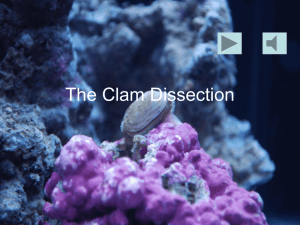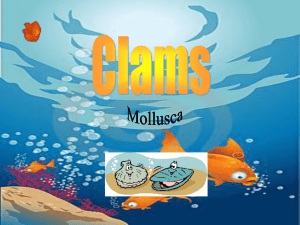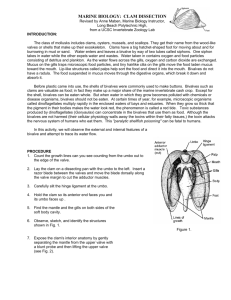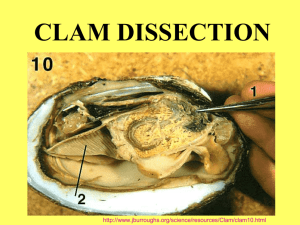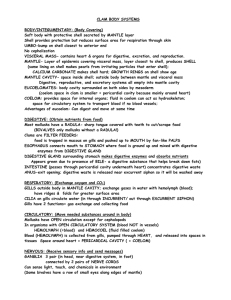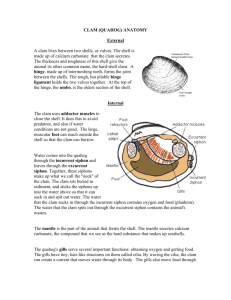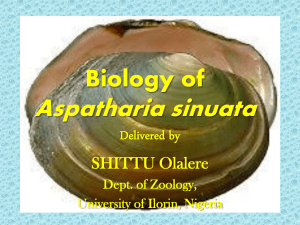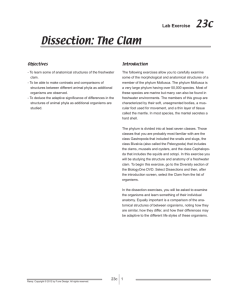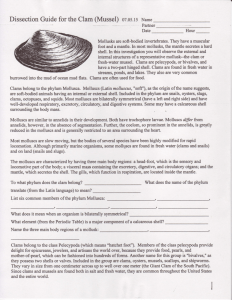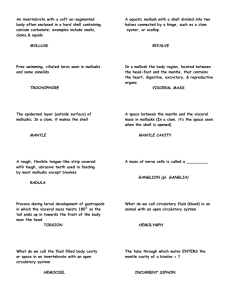NAME CLAM LAB Kingdom: Animalia Phylum: Mollusca “soft body
advertisement
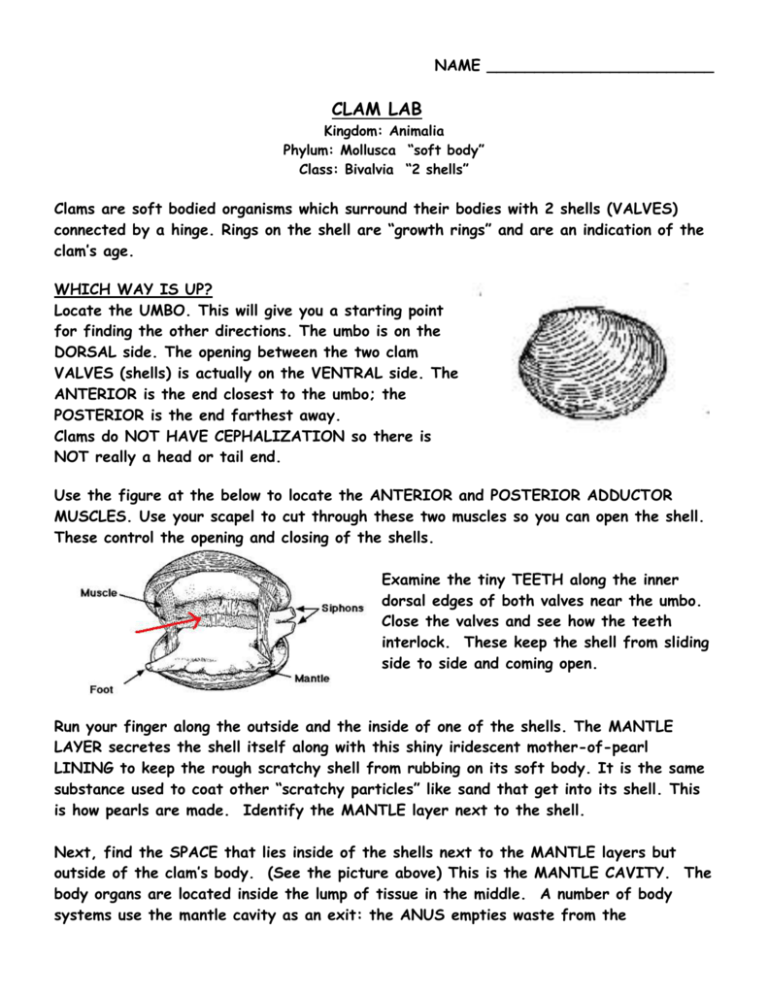
NAME ________________________ CLAM LAB Kingdom: Animalia Phylum: Mollusca “soft body” Class: Bivalvia “2 shells” Clams are soft bodied organisms which surround their bodies with 2 shells (VALVES) connected by a hinge. Rings on the shell are “growth rings” and are an indication of the clam’s age. WHICH WAY IS UP? Locate the UMBO. This will give you a starting point for finding the other directions. The umbo is on the DORSAL side. The opening between the two clam VALVES (shells) is actually on the VENTRAL side. The ANTERIOR is the end closest to the umbo; the POSTERIOR is the end farthest away. Clams do NOT HAVE CEPHALIZATION so there is NOT really a head or tail end. Use the figure at the below to locate the ANTERIOR and POSTERIOR ADDUCTOR MUSCLES. Use your scapel to cut through these two muscles so you can open the shell. These control the opening and closing of the shells. Examine the tiny TEETH along the inner dorsal edges of both valves near the umbo. Close the valves and see how the teeth interlock. These keep the shell from sliding side to side and coming open. Run your finger along the outside and the inside of one of the shells. The MANTLE LAYER secretes the shell itself along with this shiny iridescent mother-of-pearl LINING to keep the rough scratchy shell from rubbing on its soft body. It is the same substance used to coat other “scratchy particles” like sand that get into its shell. This is how pearls are made. Identify the MANTLE layer next to the shell. Next, find the SPACE that lies inside of the shells next to the MANTLE layers but outside of the clam’s body. (See the picture above) This is the MANTLE CAVITY. The body organs are located inside the lump of tissue in the middle. A number of body systems use the mantle cavity as an exit: the ANUS empties waste from the DIGESTIVE system into this space, the EXCRETORY system empties nitrogen waste into this space, and finally the REPRODUCTIVE system releases sperm or eggs into this space. Locate the 2 openings at the posterior end of the clam where the mantle layers come together. The more ventral opening (lower) is the INCURRENT SIPHON where water enters. The more dorsal opening is the EXCURRENT SIPHON where water exits. With scissors, carefully cut away the half of the mantle that lines the left valve. Once this is removed you will be able to see the gills. The GILLS in a clam serve 2 purposes… they are respiratory organs for EXCHANGING GASES (oxygen and CO2 ) and they TRAP FOOD. CILIA ON THE GILLS pull water into the MANTLE CAVITY through the INCURRENT siphon, move it over the gills, and back out through the EXCURRENT siphon. The water passing over the gills exchanges gases with the HEMOLYMPH (blood in an organism with open circulation) inside the clam and small food particles in the water are trapped in the mucous on the gills. HOW DO GASES EXCHANGE? Remember from Cell Biology that gases will move by DIFFUSION from region of HIGHER concentration to a region of LOWER concentration. So… oxygen (O2) moves from the surrounding water into the clam and carbon dioxide (CO2) moves from the clam out into the surrounding water automatically. Observe the FOOT of the clam, which is ventral to the gills. Press on it with your finger. Note the shape. Can you see why clams were once classified in the PHYLUM Pelecypoda (“hachet foot”)? Locate the PALPS, fan-like structures that move food up from the gills and guide it into the clam’s MOUTH. Beneath the edge of the palps, you will find the MOUTH. Clams are FILTER FEEDERS. That means they strain food from the water rather than hunt and catch it. The clam’s body is divided into 2 main sections. The HEAD-FOOT which contains the mouth and some sensory organs and the large muscular FOOT used for locomotion. Above the head-foot is the VISCERAL MASS which contains the heart, excretory, digestive, and reproductive organs. With your scissors, cut off the ventral portion of the foot as shown by the dashed lines in the diagram. Carefully cut the muscle at the top of the foot into right and left halves. Carefully peel the muscle layer away. You should now be able to see the internal organs. REPRODUCTIVE: Most species of clam have SEPARATE SEXES. There are both male and female clams. The GONADS or reproductive organs (TESTES or OVARIES) are located dorsally near the pericardial cavity. Eggs and sperm are released into the mantle cavity. Fertilization in clams depends on the species: MARINE (ocean dwelling) clams – EXTERNAL FERTILIZATION Eggs and sperm are released into the mantle cavity and leave by excurrent siphon FRESHWATER clams- INTERNAL FERTILIZATION Sperm enter mantle cavity through the incurrent siphon; developing larva are discharged through the excurrent siphon and grow to adults. Aquatic mollusks have INDIRECT DEVELOPMENT. The fertilized egg becomes a TROCHOPHORE LARVA with cilia for locomotion. This larva is free swimming and eventually settles to the bottom and becomes an adult. As adults clams are SESSILE . . . that means they stay in one place and don’t move around much. DIGESTIVE: Just ventral to the umbo, find the DIGESTIVE GLAND, a greenish structure that surrounds the STOMACH. This gland makes digestive enzyme called BILE which helps the intestine break down FATS in food. Extending from the stomach is a long coiled INTESTINE. Food enters the stomach where digestion begins with the addition of bile and grinding of the food. Digestible particles move into the DIGESTIVE GLAND where digestion is finished and nutrients are absorbed. The intestine collects and removes digestive waste. The intestine passes underneath the HEART. See if you can follow the digestive system toward the posterior end of the clam and find the ANUS. Feces empty into the mantle cavity just behind the POSTERIOR ADDUCTOR MUSCLE and near the EXCURRENT SIPHON. Since clams don’t move, placing the exit opening for digestive waste in this position allows digestive waste leaving the anus to be washed away by water exiting through the excurrent siphon. CIRCULATORY: Clams have an OPEN circulatory system, meaning that the circulatory fluid (HEMOLYMPH) does not remain in vessels. It is collected from the gills, pumped thorough the heart, and released directly into spaces in the tissues. Open circulation is NOT AS EFFICIENT as a closed system because nutrients and oxygen are not pumped directly to organs. In addition, high oxygen and low oxygen blood can mix allowing fewer nutrients and oxygen to reach the cells. EXCRETORY: The excretory organ in clams is the KIDNEY. This organ collects nitrogen waste produced by body cells from the break down of proteins and excretes it into the mantle cavity where it is removed with water exiting through the excurrent siphon. The kidney also maintains the balance of water and ions in the body (OSMOREGULATION). NERVOUS: Clams have NO CEPHALIZATION. There is NO distinct head area. I A clam’s nervous system consists of 3 PAIRS of GANGLIA throughout the body connected by TWO PAIRS of long NERVE CORDS. Nerve cells in the ganglia control the muscles involved in locomotion and feeding, and process sensory info about light, touch, and chemicals (food) in the water. NAME ______________________________ CLAM LAB QUESTIONS CLAMS belong in the: KINGDOM ____________________ PHYLUM ____________________ CLASS: ___________________ 1 . What controls the opening and closing of the clam’s valves? _________________________________________ 2. Clams are FILTER FEEDERS. Explain what that means. _____________________________________________________________________ 4. The location of the gills are located in the ______________________ cavity. 5. Why do you think the surface of the gills has ridges instead of being flat and smooth? _____________________________________________________________________ 6. Adult clams are SESSILE. What does that mean? ___________________________________________________ 7. In Biology you learned about DIFFUSION (molecules moving automatically from an area of HIGH concentration to an area of LOW concentration). Explain how DIFFUSION helps oxygen move in and carbon dioxide move out of gills. _____________________________________________________________________ 8. What are the 2 functions of the gills in a clam? _____________________________ _________________________________ 9. Explain why it is a good design for a clam to have its anus located next to the excurrent siphon? _____________________________________________________________________ 10. Which part of the digestive system in clams runs underneath the heart ? ________________________________ NAME THE BODY PART Bump on shell _____________________ Layer that produces the shell ______________________ Collects and removes nitrogen waste _______________________________ & helps with osmoregulation Makes bile to help break down fat in food _________________________ Area of body containing heart, digestive Reproductive, and excretory organs ____________________________ Muscular part used for locomotion _____________________ Exchanges gases with water ________________________ Finishes digestion and absorbs nutrients ____________________________ (Be careful on this one!) Traps food in the mucous on its ridged surface __________________________ Space between mantle and visceral mass (location of gills) ________________________ Controls opening and closing of shells ______________________________ Fan-like structures that move food toward mouth ________________________ Opening for water entering mantle cavity ____________________________ Opening for water leaving mantle cavity ____________________________ Pumps hemolymph (blood) _____________________________ Starts digestion and grinds food ____________________________ Collects and removes digestive waste (feces) _________________________
